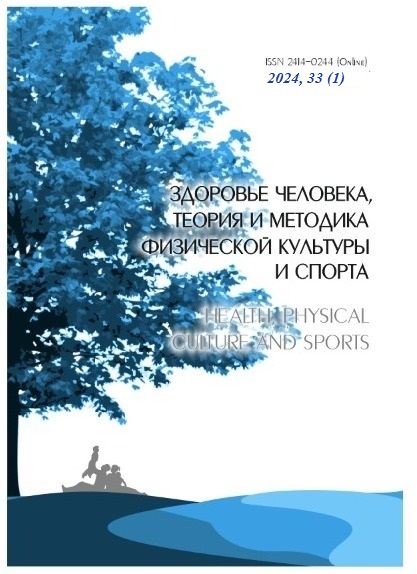ROCK CLIMBING COACHES ATTITUDE TO DEVELOPMENT GRIP STRENGTH
Abstract
The study examines using tools and methods by coaches to develop grip strength in climbers at various stages of training, specializing in difficulty and bouldering. Questionnaire used as research method. 63 rock climbing coaches from 27 Russian cities took part in the survey. Established that as athletes become more prepared, coaches provide a larger volume of special exercises to develop grip strength. Most coaches prefer using fingerboard, campusboard, and special exercises at the climbing wall. Working with high level athletes more experienced coaches more often use special exercises to develop grip strength. Most popular method to develop grip strength is the mean time to failure. According to trainers, the limiting factor for climbers is forearms muscles development of strength endurance. It is necessary to include at least 15% volume of exercises aimed to developing grip strength from the total volume of training for top-level rock climbers.
Downloads
References
Мищенко Н. Ю. Развитие координационных способностей спортсменов 10-12 лет, занимающихся скалолазанием //Культура физическая и здоровье. 2020. №. 2. С. 111–120.
Севостьянова Е. В. Педагогическая технология повышения стрессоустойчивости у спортсменов-скалолазов : автореф. дис. ... канд. пед. наук: 13.00.04. М., 2021.
Терентьев С. А., Завьялова О. Б. Выявление особенностей организации тренировочного процесса скалолазов // Педагогика и современное образование: традиции, опыт и инновации. 2018. С. 203–205.
Хаттинг Г. Скалолазание: базовое руководство по снаряжению и техническому оснащению. М., 2006.
Baláš J., Michailov, M., Giles, D., Kodejška, J., Panáčková, M., & Fryer, S. (2016). Active recovery of the finger flexors enhances intermittent handgrip performance in rock climbers. European journal of sport science, 16(7). P. 764-772.
Fanchini M., Violette F., Impellizzeri F. M., & Maffiuletti N. A. (2013). Differences in climbingspecific strength between boulder and lead rock climbers. The Journal of Strength & Conditioning Research, 27(2). P. 310-314.
Fryer S., Stone K. J., Sveen J., Dickson T., España-Romero V., Giles D., ... & Draper N. (2017). Differences in forearm strength, endurance, and hemodynamic kinetics between male boulderers and lead rock climbers. European journal of sport science, 17(9). P. 1177-1183
Giles D. (2021). An all-out test to determine finger flexor critica... ijspp, 2020, 0637.
Giles D., Barnes, K., Taylor, N., Chidley, C., Chidley, J., Mitchell, J., ... & España-Romero, V. (2021). Anthropometry and performance characteristics of recreational advanced to elite female rock climbers. Journal of Sports Sciences, 39(1). P. 48-56.
Grant S. (2003). Climbing-specific finger endurance: a comparative...
Horst E. (2008). Training for climbing: The definitive guide to improving your performance. Rowman & Littlefield.
Kodejška J., Michailov, M. L., & Baláš, J. (2016). Forearm muscle oxygenation during sustained isometric contractions in rock climbers. Auc Kinanthropologica, 51(2). P. 48-55.
Limonta E., Cè E., Veicsteinas A., & Esposito F. (2008). Force control during fatiguing contractions in elite rock climbers. Sport Sciences for Health, 4, 37-42.
Macias, K. M., Brown, L. E., Coburn, J. W., & Chen, D. D. (2015). A comparison of upper body strength between rock climbing and resistance trained men. Sports, 3(3). P. 178-187.
McMullen C. W., Mugleston, B. J., & Booker, L. N. (2021). Coaches’ Attitudes Toward Campus Board Training in Adolescent Climbers in the United States. Wilderness & Environmental Medicine, 32(2). P. 168-175.
Ozimek M., Rokowski R., Draga P., Ljakh V., Ambroży T., Krawczyk M., ... & Mucha, D. (2017). The role of physique, strength and endurance in the achievements of elite climbers. PLoS One, 12(8), e0182026.
Ozimek M., Staszkiewicz R., Rokowski R., & Stanula A. (2016). Analysis of tests evaluating sport climbers’ strength and isometric endurance. Journal of human kinetics, 53. 249 p.
Philippe M., Wegst D., Müller T., Raschner C., & Burtscher M. (2012). Climbing-specific finger flexor performance and forearm muscle oxygenation in elite male and female sport climbers. European journal of applied physiology, 112. P. 2839-2847.
Wall C. B., Starek J. E., Fleck S. J., & Byrnes, W. C. (2004). Prediction of indoor climbing performance in women rock climbers. The Journal of Strength & Conditioning Research, 18(1). P. 77-83.
Copyright (c) 2024 Health, physical culture and sports

This work is licensed under a Creative Commons Attribution-NonCommercial 4.0 International License.
An author should not normally publish manuscripts describing essentially the same research in multiple journals or publication venues. Such redundant publication is generally considered to constitute unethical publishing behavior, and if discovered may result in a manuscript under consideration being rejected, or a published article being retracted.
Authors of manuscripts reporting on original research should present an accurate account of the work performed, accompanied by an objective discussion of its significance. Underlying data should be represented accurately in the manuscript. The manuscript should contain sufficient detail and references to permit others to replicate the work. The fabrication of results and the making of fraudulent or knowingly inaccurate statements constitute unethical behavior and may be cause for rejection or retraction of a manuscript or published article.





